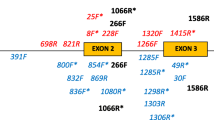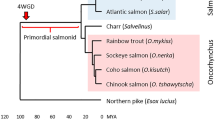Abstract
A characteristic feature of the major histocompatibility complex (Mhc) polymorphism in mammals is the existence of allelic lineages shared by related species. This trans-species polymorphism has thus far been documented only in primates, rodents, and artiodactyls. In this communication we provide evidence that it also exists in cyprinid (bony) fishes at the class IIA andB loci coding for the α and β polypeptide chains of the class II α: β heterodimers. The study has focused on three species of the family Cyprinidae, subfamily Rasborinae: the zebrafish (Danio rerio), the giant danio (D. malabaricus), and the pearl danio (D. albolineatus). The polymerase chain reaction was used to amplify and then sequence intron 1 and exon 2 of the class IIB loci and exon 2 of the class IIA loci in these species. Phylogenetic analysis of the sequences revealed the existence of allelic lineages whose divergence predates the divergence of the three species at both theA andB loci. The lineages at theB locus in particular are separated by large genetic distances. The polymorphism is concentrated in the peptide-binding region sites and is apparently maintained by balancing selection. Sharing of this uniqueMhc feature by both bony fishes and mammals suggests that the main function of theMhc (presentation of peptides to T lymphocytes) has not changed during the last 400 million years of its evolution.
Similar content being viewed by others
References
Arden, B. and Klein, J. Biochemical comparison of major histocom-patibility complex molecules from different subspecies ofMus musculus: evidence for trans-spefific evolution of alleles.Proc Natl Acad Sci USA 79: 2342–2346, 1982
Barman, R. P. A taxonomic revision of the Indo-Burmese species ofDanio Hamilton Buchanan (Pisces: Cyprinidae).Rec Zool Surv India 137: 1–91, 1991
Brown, J. H., Jardetzky, T. S., Saper, M. A., Samraoui, B., Bjorkman, P. J., and Wiley, D. C. A hypothetical model of the foreign antigen binding site of class II histocompatibility molecules.Nature 332: 845–850, 1988.
Brown, J. H., Jardetzky, T. S., Gorga, J. C., Stern, L. J., Urban, R. G., Strominger, J. L., and Wiley, D. C. Three-dimensional structure of the human class II histocompatibility antigen HLA-DR1.Nature 364: 33–39, 1993
Fan, W., Kasahara, M., Gutknecht, J., Klein, D., Mayer, W. E., Jonker, M., and Klein, J. Shared class IIMhc polymorphisms between human and chimpanzees.Hum Immunol 26: 107–121, 1989
Figueroa, F. and Klein, J. Origin of H-2 polymorphism.In C. S. David (ed.):H-2 Antigens, Genes, Molecules, Function. Series A: Life Sciences 144, pp. 61–76, Plenum Publishing Corporation, 1987
Figueroa, F., Günther, E., and Klein, J. MHC polymorphism pre-dating speciation.Nature 335: 265–267, 1988
Grimholt, U., Olsaker, I., De Vries Linstroem, C., and Lie, Ø. A study of variability in the MHC class II β1 and the MHC class I α2 domain exons of Atlantic salmon (Salmo salar).Anim Genet 25: 147–153, 1994.
Gyllensten, U., Sundvall, M., Ezcurra, I., and Erlich, H. A. Genetic diversity at class II DRB loci of primate Mhc.J Immunol 146: 4368–4376, 1991
Gyllensten, U. B. and Erlich, H. A. Ancient roots for polymorphism at the HLA-DQα locus in primates.Proc Natl Acad Sci USA 86: 9986–9990, 1989
Hamilton-Buchanan, F.An Account of the Fishes Found in the River Ganges and its Branches, Archibald Constable, Edinburgh 1822.
Hardee, J. J., Godwin, U., Benedetto, R., and McConnell, T. J. Major histocompatibility complex class IIA gene polymorphism in the striped bass.Immunogenetics 41: 229–238, 1995
Higgins, D. G., Bleasby, A. J., and Fuchs, R. CLUSTAL V: improved software for multiple sequences aligment.Cabios 8: 189–191, 1992.
Hughes, A. L. and Nei, M. Pattern of nucleotide substitution at major histocompatibility complex class I loci reveals overdominant selection.Nature 355: 167–170, 1988
Hughes, A. L. and Nei, M. Nucleotide substitution at major histocompability complex class II loci: evidence for overdominant selection.Proc Natl Acad Sci USA 86: 958–962, 1989
Kenter, M., Otting, N., Anholts, J., Jonker, M., Schipper, R., and Bontrop, R. E.Mhc-DRB diversity of the chimpanzee.Immunogentics 37: 1–11, 1992
Kimura, M. A simple method for estimating evolutionary rates of base substitutions through comparative studies of nucleotide sequences.J Mol Evol 16: 111–120, 1980
Klein, D., Ono, H., O'hUigin, C., Vincek, V., Goldschmidt, T., and Klein, J. Extensive MHC variability in cichlid fishes of Lake Malawi.Nature 364: 330–334, 1993
Klein, J. Generation of diversity at MHC loci: implications for T-cell receptor repertoires.In M. Fougereau and L. Dausset (eds.):Immunology 80, pp. 239–253. Academic Press, London, 1980
Klein, J.Natural History of the Major Histocompatibility Complex, John Wiley, New York, 1986
Klein, J. Origin of major histocompatibility complex polymorphism: the trans-species hypothesis.Hum Immunol 19: 155–162, 1987
Klein, J. and Figueroa, F. Evolution of the major histocompatibility complex.CRC Crit Rev Immunol 6: 295–386, 1986
Klein, J. and O'hUigin, C. Class II BMhc motifs in an evolutionary perspective.Immunol Rev 143: 89–111, 1995
Klein, J. and Takahata, N. The major histocompatibility complex and the quest for origins.Immunol Rev 113: 5–25, 1990
Klein, J., Bontrop, R. E., Dawkins, R. L., Erlich, H. A., Gyllensten, E. B., Heise, E. R., Jones, P. P., Parham, P., Wakeland, E. K., and Watkins, D. I. Nomenclature for the major histocompatibility complexes of different species: a proposal.Immunogenetics 31: 217–219, 1990a
Klein, J., Kasahara, M., Gutknecht J., and Figueroa, F. Origin and function ofMhc polymorphism.Chem Immunol 49: 35–50, 1990b
Klein, J., Satta, Y., O'hUigin, C., and Takahata, N. The molecular descent of the major histocompatibility complex.Annu Rev Immunol 11: 269–295, 1993
Kumar, S., Tamura, K., and Nei, M.MEGA: Molecular Evolutionary Genetic Analysis Version 1.0 The Pennsylvania State University, University Park, PA, 1993
Kupfermann, H., Mayer, W. E., O'hUigin, C., Klein, D., and Klein, J. Shared polymorphism between gorilla and human major histocompatibility complexDRB loci.Hum Immunol 34: 267–278, 1992
Laird, P. W., Zijderveld, A., Linders, K., Rudnicki, M. A., Jaenisch, R., and Berns, A. Simplified mammalian DNA isolation procedure.Nucleic Acids Res 19: 4293, 1991
Lawlor, D. A., Ward, F. E., Ennis, P. D., Jackson, A. P., and Parham, P.HLA-A and-B polymorphism predate the divergence of humans and chimpanzees.Nature 335: 268–271, 1988
Li, W.-H., Wu, C.-I., and Luo, C.-C. A new method for estimating synonymous and nonsynonymous rates of nucleotide substitution considering the relative likelihood of nucleotide and codon changes.Mol Biol Evol 2: 150–174, 1985
Maniatis, T., Fritsch, E. F., and Sambrook, J.,Molecular Cloning: A Laboratory Manual, Cold Spring Harbor Laboratory, Cold Spring Harbor, New York, 1991
Mayer, W. E., Jonker, M., Klein, D., Ivanyi, P., van Seventer, G., and Klein, J. Nucleotide sequences of chimpanzeeMhc, class I alleles: evidence for trans-species mode of evolution.EMBO J 7: 2765–2774, 1988
Mayer, W. E., O'hUigin, C., Zaleska-Rutczynska, Z., and Klein, J. Trans-species origin ofMhc-DRB polymorphism in the chimpanzee.Immunogenetics 37: 12–23, 1992
McConnell, T. J., Talbot, W. S., McIndoe, R. A., and Wakeland, E. K. The origin ofMhc class II gene polymorphism within the genusMus.Nature 332: 651–654, 1988
Meyer, A., Biermann, C. H., and Ortí, G. The phylogenetic position of the zebrafish (Danio rerio), a model system in developmental biology: an invitation to the comparative method.Proc R Soc Lond (Biol) 252: 231–236, 1993
Meyer, A., Ritchie, P. A., and Witte, K.-E. Predicting developmental processes from evolutionary patterns: a molecular phylogeny of the zebrafish (Danio rerio) and its relatives.Phil Trans R Soc Lond (Biol) 349: 103–111, 1995
Nelson, J. S.Fishes of the World, John Wiley, New York, 1984
O'hUigin, C. Quantifying the degree of convergence in primate Mhc-DRB genes.Immunol Rev 143: 123–140, 1995
Ono, H., Klein, D., Vincek, V., Figueroa, F., O'hUigin, C., Tichy, H., and Klein, J. Major histocompatibility complex class II genes of zebrafish.Proc Natl Acad Sci USA 89: 11886–11890, 1992
Ono, H., O'hUigin, C., Tichy, H., and Klein, J. Major-histocompatibility-complex variation in two species of cichlid fishes from Lake Malawi.Mol Biol Evol 10: 1060–1072, 1993
Ono, H., O'hUigin, C., Vincek, V., and Klein, J. Exon-intron organization of fish major histocompatibility complex class IIB genes.Immunogenetics 38: 223–234, 1993b
Ono, H., O'hUigin, C., Vincek, V., Stet, R. J. M., Figueroa, F., and Klein, J. New β chain-encodingMhc class II genes in the carp.Immunogenetics 38: 146–169, 1993c
Saitou, N. and Nei, M. The neighbor-joining method: a new method for reconstructing phylogenetic trees.Mol Biol Evol 4: 406–425, 1987
Sanger, F., Nicklen, S., and Coulson, A. R. DNA sequencing with chain-terminating inhibitors.Proc Natl Acad Sci USA 74: 5463–5467, 1977
Sato, A., Figueroa, F., O'hUigin, C., Reznick, D. N., and Klein, J. Major histocompatibility complex genes of the guppy,Poecilia reticulata: identification and cloning.Immunogenetics 43: 38–49, 1996
Satta, Y., Takahata, N., Schönbach, C., Gutknecht, J., and Klein, J. Calibrating evolutionary rates at major histocompatibility complex loci.In J. Klein and D. Klein (eds.):Molecular Evolution of the Major Histocompatibility Complex, pp. 51–62, Springer, Heidelberg, 1991
Satta, Y., O'hUigin, C., Takahata, N., and Klein, J. The synonymous substitution rate of the major histocompatibility complex loci in primates.Proc Natl Acad Sci USA 90: 7480–7484, 1993
Slierendregt, B. L., van Noort, J., Bakas, R. M., Otting, N., Jonker, M., and Bontrop, R. E. Evolutionary stability of trans-species major histocompatibility complex class IIDRB lineages in man and rhesus monkey.Hum Immunol 35: 29–39, 1992
Stanley, S. M. A theory of evolution above the species level.Proc Natl Acad Sci USA 72: 646–650, 1975
Sültmann, H., Mayer, W. E., Figueroa, F., O'hUigin, C., and Klein, J. ZebrafishMhc class II α chain-encoding genes: polymorphism, expression, and function.Immunogenetics 38: 408–420, 1993
Sültmann, H., Mayer, W. E., Figueroa, F., O'hUigin, C., and Klein, J. Organization ofMhc class IIB genes in the zebrafish (Brachydanio rerio).Genomics 23: 1–14, 1994a
Sültmann, H. Organisation and Charakterisierung vonMhc Klasse IIA undB Genen des Zebrabärblings (Brachydanio rerio). Universität Tübingen, 1994b
Wakeland, E. K., Tarruzzee, R. W., Lu, C.-C., Potts, W., McIndoe, R. A., Talbot, W. S., and McConnell, T. J.In C. S. David (ed.):H-2 Antigens, Genes, Molecules, Function, pp. 139–153, Plenum Press, New York, 1987
Walker, R. B. and McConnell, T. J. Variability in anMhcMosa class II β chain-encoding gene in the striped bass (Morone saxatilis).Dev Comp Immunol 18: 325–342, 1994
Wu, T. T. and Kabat, E. A. An analysis of the sequences of the variable regions of Bence Jones proteins and myeloma light chains and their implications for antibody complementarity.J Exp Med 132: 211–250, 1970
Author information
Authors and Affiliations
Rights and permissions
About this article
Cite this article
Graser, R., O'hUigin, C., Vincek, V. et al. Trans-species polymorphism of class IIMhc loci in danio fishes. Immunogenetics 44, 36–48 (1996). https://doi.org/10.1007/BF02602655
Received:
Revised:
Issue Date:
DOI: https://doi.org/10.1007/BF02602655




